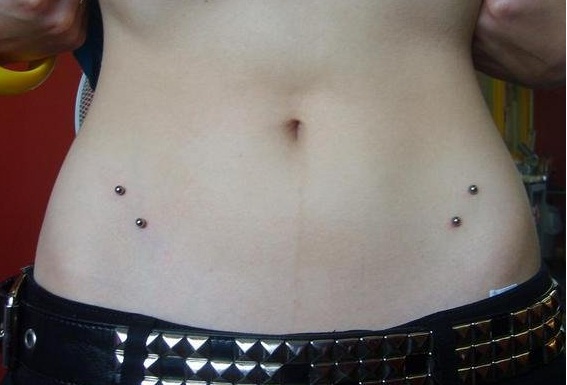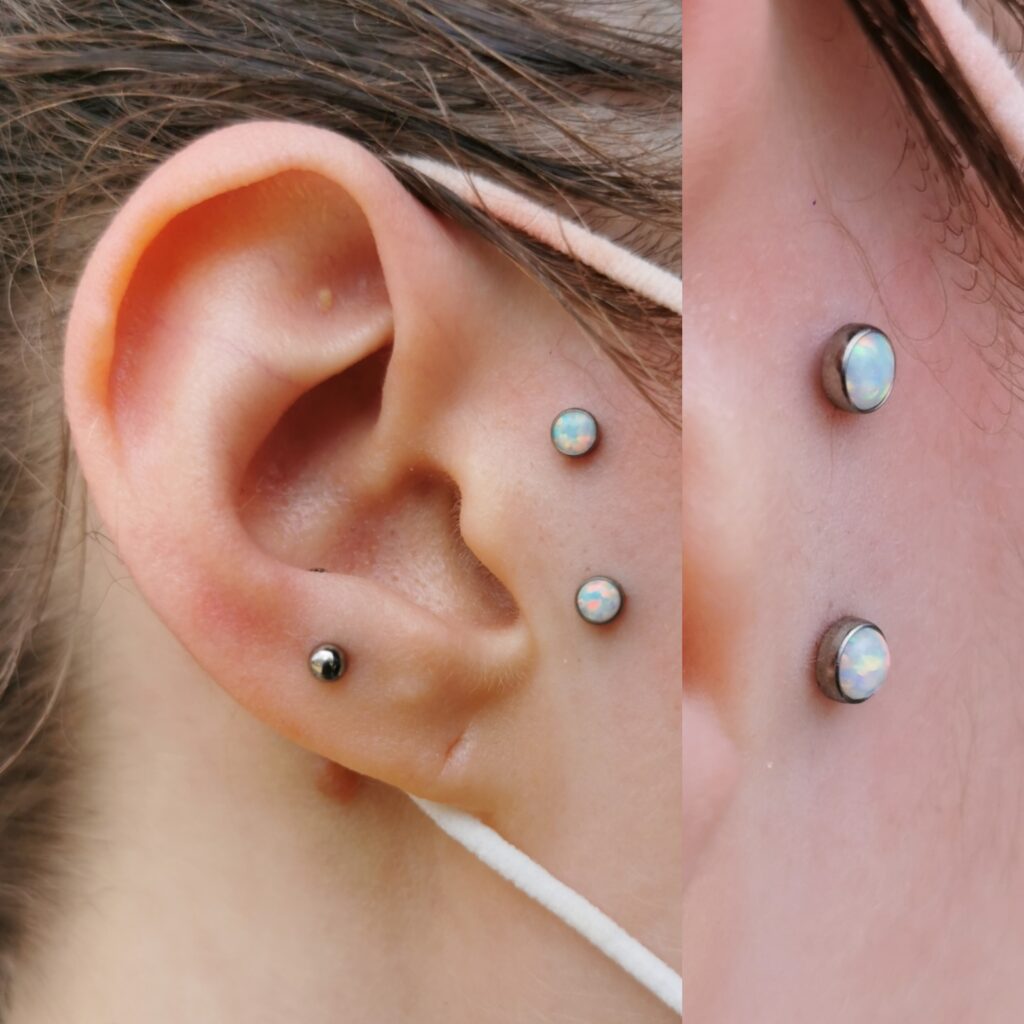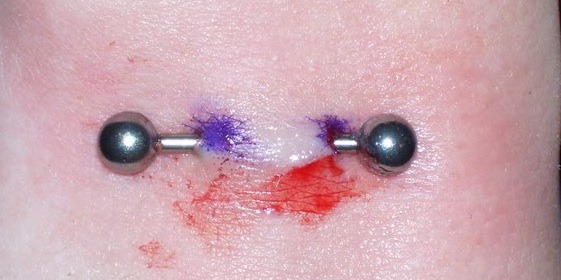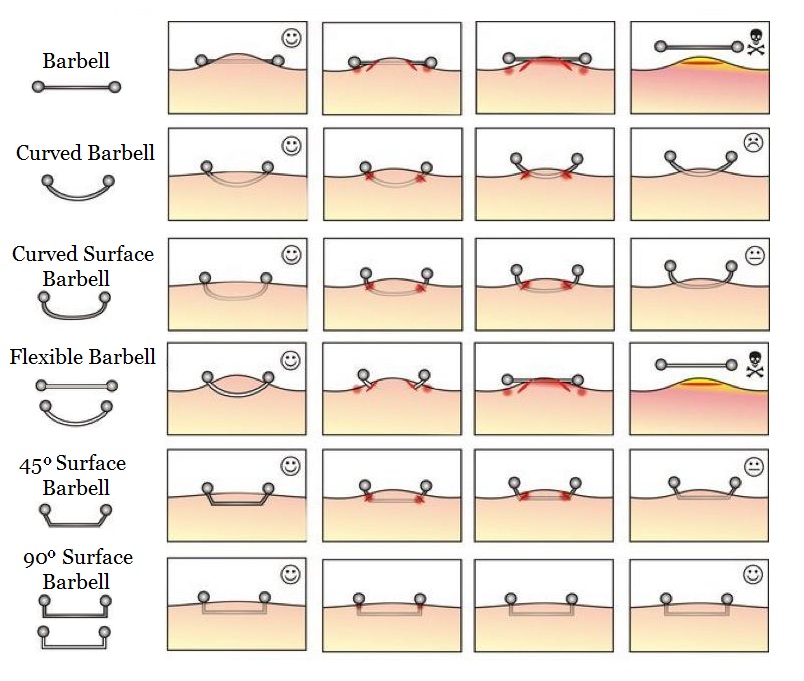Surface piercings are rising in popularity, and are often grouped with Microdermals and Skin Divers (see my other blog) as they are a similar aesthetic, and have similar advantages and disadvantages. This note is to explain what they are, how they are done and the problems associated. See my blog on microdermals/skin divers for info specific to them: http://skinseamstress.com/wp/2021/05/21/microdermals-skin-divers/
While I always encourage people to try things out, and to get the piercings they want, I don’t recommend a surface piercing as your first piercing. I tell every client getting a surface piercing to see it as a temporary thing, as they often have issues healing and if they don’t heal, they will have to be removed or they can ‘grow out’ on their own. Not something I want to bestow upon someone for their first piercing experience!
I hate having to crush people’s dreams of a beautiful new piercing with this info, but I also don’t want to sell someone something that doesn’t live up to their expectations. This will be discussed later in the blog, but I feel I need to mention it before getting into the subject, as it is a very important consideration. Going into this with the knowledge of all possibilities is absolutely the best way. Forewarned is forearmed. In short, if you will be absolutely devastated at having to retire a piercing (take it out permanently) then surface piercing is probably not the one for you.
Of course, as with any piercing, I encourage clients to come back and see me if there are any problems with it, and I will always offer help and guidance. Returning to me (or your piercer) at the first sign of trouble with this kind of piercing is essential, as the scarring left by surface piercings can be minimalized by removing the piercing in the early stages of migration (‘growing out’). Any assistance needed with a piercing I performed is free of charge.
What Are Surface Piercings?
Most people have seen these types of piercings before, they are very popular, despite their [relatively] low success rate. They can be done virtually anywhere on the body – common places include wrists, back of the neck (nape), hips, collarbones (clavicle), cleavage/sternum and high on the cheekbone (often referred to as an anti-eyebrow). Some placements have a better chance of healing than others, which will be discussed later in this blog.
The piercing is done with a 3-part piece of titanium jewellery, which consists of a bar with two 90-degree bends in it, and a screw-in ball or disk on either end – both ends can be removed and changed once the piercing is settled. The bar-part is not removed from your body unless the piercing is to be taken out permanently; the balls/disks are the only things that are changed on the piercing. I HAVE seen 100% healed surface piercings be able to be removed completely and replaced (for scans, surgery, etc) and survive, but it is not something I would recommend other than as a last resort.
Let’s take a better look at the jewellery, the bars are often returned to as ‘Staple Bars’ (so-called because they look a bit like office staples) but are sometimes referred to as ‘surface barbells’ or ‘jazz bars’.

This shows the 2 types of surface bar I use; the top piece is a ‘flat surface bar’ and the lower one is a ‘standard surface bar’. You can see one end has been removed on each, but both ends can be removed. They are available in different lengths – the longest part of the bar is different, and the posts can be different heights – the little stumps where the ends attach can be longer/shorter. I usually show clients the lengths that are available for their chosen placement and allow them to select their preferred length.
When fitted, only the balls/disks are visible, and they look like this (these were done by me):


Hip piercing was a very popular thing back in the mid ‘00s (showing my age here!) when high-waisted jeans were unheard of! The hip piercings are with standard surface bars, the tragus surface piercing is with a flat surface bar (opal disks).
Here’s a cross section showing how they sit:

How Are They Done?
Surface piercings are usually done at 1.6mm/14g, but I have used 1.2mm/16g staple bars in the past, on areas with much thinner skin – but with the availability of the flat surface bar (pictured above), I use these now instead. All the surface work I do is now at 1.6mm/14g with internal threads (the same as microdermals).
The procedure is the same as most other piercings, the area is cleaned, checked, marks are made, checked again and then checked by the client. The client is asked to lie down (I can’t think of any surface piercing placement that I’d do sitting up). A needle is passed under the skin at one of the marks, then out on the other. The jewellery is inserted while attached to an insertion pin which is slid partially into the needle. Because of the irregular shape of the bar, it can feel a little uncomfortable getting it into place – like a tight/pulling feeling. I use a packet of sterile water-based lubricant to help the jewellery slide through more easily.
The pain is not as much as people imagine; these are usually done on soft, pliable tissue which is generally less painful. You feel 2 separate ‘stings’ with a short gap in between. There are other methods of doing these (such as a ‘punch and taper’ method, but I find a wound shaping technique works best for me, and is more comfortable for my clients).
Usually there is a little blood – as with any piercing – and they can sometimes bruise as well. I don’t usually put a plaster/dressing on the piercing if it’s not covered by clothing (back of neck/face) but for torso placements, I usually would. (Side note – if you have an allergy to adhesives/dressings, always tell your piercer!)
How Do I Look After It?
Taking care of this type of piercing is quite simple, be gentle with it and clean it gently once a day, using saline, and make sure it is dried THOROUGHLY after baths/showers and cleaning. Other than that, leave it well alone. Using some gauze or kitchen roll, you can ‘floss’ around the bars to help keep them clean, and I have seen unfragranced dental floss used too, which works well to get any ‘crusties’ off the jewellery. I don’t recommend any soaking for at least the first 2 weeks, and avoid swimming/chlorinated/shared water for a minimum of 1 month. It can get quite sore for the 1st few days, and swelling/bruising is very common, but usually settles within a week.
Changing the balls/disks on the piercing is best done when the piercing has settled, as touching/moving the bar can irritate the piercing further. These piercings can take up to a year to heal fully, but like Microdermals and Skin Divers they are usually settled (not healed) after a month or 2, I would always recommend returning to your piercer for them to be changed as they can be difficult.
What Jewellery Options Are Available?
Lots! Any internally threaded attachments for 1.6mm/14g posts will fit. However, it is best to keep the attachments small and neat (no big/fancy clusters) to avoid snagging/pulling.
Something I try to explain to clients when they are selecting their jewellery with these is to avoid anything with a defined ‘top’ to the design. Meaning a shaped attachment like a heart or lightning bolt (which looks best when sitting at a certain angle with the ’top’ of the piece orientated at the ‘top’) would not be ideal, as once it is screwed into place and tightened, it may not sit the ‘right way up’. This isn’t an issue with ear piercing, tongue piercing, lip piercing, etc as the piece can just be turned (with the stud) to sit correctly, but as the bar under your skin cannot be moved or orientated differently, this isn’t possible, and if the attachment is not tightened fully, it could fall out easily. A solution to this in other piercings (rooks, navels, eyebrows, VCH) where the bar has to sit a certain way, is to use threadless (‘push fit’) jewellery, which can be turned in the post to sit the desired way. But surface bars (and microdermals) are not available as threadless, as their posts are not long enough to accommodate the pin. So, this is another consideration for you – microdermals can be pierced with a specific end sitting a specific way (they MUST be pierced with this end to be sure it sits correctly) but as surface bars have to be along a certain plane of your body, the long part of the bar can’t be placed at an angle, so it’s not always possible. Sticking to gem/opal disks or things like stars/flowers (that don’t have a defined ‘top’, they can sit any which way up) is best. This is a really hard concept to explain, if you want to have a chat about it in person, please call in!
So How Long Do They Last?
This is the question everyone wants the answer to! As mentioned briefly, surface piercings are notorious for being problematic and having a (relstively) short lifespan compared to other piercings. The piercing sits along the same plane of the skin with 2 ‘puncture wounds’ that the jewellery leaves through. The piercing is quite shallow (2-4mm under the surface – you can usually feel the jewellery under the skin). Your body sees this as something it could push out – which is what bodies do when there is a foreign object in there. This is why depth and placement are so important. While the healing process is in the early stages, your body makes the decision on whether to try and hold the piercing in place and heal around it – which is what we want it to do, or whether it would be less hassle/trauma to push it out.
As mentioned earlier, certain placements work better than others (or rather, have a higher success rate). For surface piercing, the nape of the neck and on the sternum tend to have a higher success rate. Placements like the top of the wrist or hips very rarely heal fully.
If your piercer suggests a placement or position that you don’t like, discuss it with them, but do understand that we need to place this kind of piercing in a way that has the best chance of staying put. For example, I don’t offer surface piercing on hands and feet, and legs/arms would only be an option if the client had previously healed a surface piercing elsewhere, but I would always advise against getting one on legs/arms, and suggest microdermal(s) instead.
Personally, I have had 3 surface piercings done, the shortest I had one was 2 weeks and the longest was just over 3 years. I normally expect surface piercings to last for a minimum of 6 months, but this is entirely dependent on how well the client looks after the piercing. I do see a lot of people in early summer who want to get a surface piercing to show off over the summer, but are aware that come Christmas, it may not still be there.
If a surface piercing is still there after a year, with no redness/irritation, I’d class it as a success.
What Are The Common Problems With Surface Piercing?
Surface piercings can do one of three things; ‘grow out’ (as mentioned above, the most common problem with surface piercing), point blank refuse to heal (but not grow out) meaning they have to be removed, or they can heal.
Healing – This is obviously what we want to happen – a healed surface piercing would be the same as any other healed piercing. No pain/discomfort/redness/discharge, jewellery can move freely, and the ‘holes’ of the piercing are concave – meaning the area around the hole looks like it’s pulled into the hole.
Not Healing – If a surface piercing hasn’t healed after about 18 months (ie. Does not look like described above) I would definitely discuss removing it with my client. We could try a different approach to aftercare, or possibly smaller/neater attachments before deciding to remove, but if we tried everything and the piercing won’t settle, removal is usually the best option. This would heal and leave 2 small ‘dots’ as scars – these would eventually sit flat and turn white.
Growing Out – This is the most common issue we see with surface piercing, this is where the skin between the 2 posts coming out of the skin starts to recede – meaning you can see the corners of the bar, and then the longer part more and more, until eventually there is nothing holding the bar in, and it falls out. I would never recommend letting a surface piercing to get to this stage, and would remove it before it gets to that point. Sometimes your body will do this completely by itself, and sometimes a piercing that has been healing well (or even fully healed) can be knocked, pulled, or snagged and this can set in motion the ‘growing out’. The first sign of the piercing growing out is dry/dead skin around the posts, and the skin between them turning red, it should be monitored closely if this happens. Sometimes taking photos of the piercing every week or so will help you see where it is headed with regard to growing out. Any piercing that grows out will leave a scar, and unfortunately, surface piercings leave a larger scar, often a ‘line’ between the 2 holes. This will heal, and shrink and turn white – but will be present/visible permanently. Do factor this into your decision to get a surface piercing, especially one on your face.
In some cases, the piercing will grow out partially, and then heal, meaning the ‘corners’ of the bar are visible, but the skin between them is healthy and in-tact. In this instance, it’s best to remove the bar and replace it with a shorter one, but in turn, this can irritate the piercing and cause it to grow out further. That’s the risk you take with doing that, unfortunately. However, I have seen this happen, and the piercing recover and be better than ever…. As Status Quo said “you pay your money, you take your choice”.
In any situation where a piercing is removed, a scar will be left. In the case of surface piercing, this is no different, but the scarring is definitely more prominent.
It is impossible to tell what will happen from person to person, or placement to placement. And as with a lot of piercings, experience is key, if you usually find piercings tricky to heal, or if you have had surface piercings done before which have caused problems, then there’s a higher possibility that you’ll struggle with healing them.
Proper jewellery choice and size is very important. As mentioned, I had one done under my navel and the piercer used a bar with posts (coming up through the skin) that were much too short, the balls embedded and 2 weeks later, that was the end of that. I had the piercing re-done with an appropriately sized bar a few years later, and I think it lasted about 18 months.
When the jewellery isn’t sized properly, or the wrong type of jewellery is used, embedding is common, and this absolutely means the piercing needs to be removed.
This piercing has been carried out using a straight barbell. (Pic from Google). Missed marks aside, notice how raised and tight the skin across the barbell is, the swelling that comes with that will cause the balls to embed, coming up around the balls causing them to press onto the tissue under them even more. There will be a lot of pressure on the area and where the balls are resting on the skin, it will eventually cut off the blood supply to the area and the skin under the balls will turn white and ‘die’. It will be painful to touch and it is highly unlikely that this will heal – it looks like it has just been done due to the blood around it.

Straight barbells (or flexible plastic barbells) should NOT be used in surface piercings. As with any piercing, check your piercer’s portfolio, ask to see fresh and healed surface piercing. Not every piercer offers surface piercing, so do speak to your piercer about it before making the decision to get it done.
The second (and most common) type of inappropriate jewellery is the curved barbell (like an eyebrow or navel bar).
Eyebrow and navel piercings are both types of surface piercings, although I would class a ‘true’ surface piercing as one where both ends of the piercing are along the same plane. I have seen curved barbell surface piercings heal, so it’s not unheard of. However, it’s not a practice I would follow, nor recommend.
This is a photo I took of a surface piercing which had been carried out with a curved barbell. This was NOT done by me; the client came to me for advice. It was removed and cleaned thoroughly, and the client requested it to be removed permanently.
This shows how the piercing wasn’t properly measured to make sure the ‘holes’ were the correct distance apart. Remember I mentioned that the skin under the screw-on balls of the barbell can ‘die’? Take a close look at the left hole; you can see that the skin around the hole has started to turn white. Both holes show signs that the balls have been ‘sucked into’ the piercing.

The barbell was placed back in the piercing, notice how much the piercing has swollen and you cannot even see one end of the barbell, and the other end is sunken in.

The diagram below shows how different types of barbells behave in surface piercing. Obviously, there will always be exceptions, but as a general rule, this is why we use 90-degree staple bars.

Can A Surface Piercing Be Re-Pierced If It Is Removed?
In short – no. It can be placed NEAR the old site, but re-piercing the exact same position usually results in the piercing growing out even faster than before. Scar tissue doesn’t have as much circulation/blood flow as unscarred tissue. This means a piercing in the same place will not heal easily – and it will mean that the existing scar gets thicker/denser if re-pierced. Using the scar as a ‘marker’ and sticking self-adhesive gems on there is always an option too – sure, it isn’t a piercing, but I won’t tell if you won’t!
I will not pretend that surface piercings will heal as easily as, say, a lobe piercing. But with proper aftercare, and a little bit of luck, they can heal and look amazing. They are prone to migrating (growing out) and will leave a scar, so this is something to consider BEFORE committing to the piercing. Knocks and bumps, over-cleaning/not cleaning enough and fiddling with/touching the jewellery can all make it difficult to heal, and increase the risk of your body rejecting the piercing out. Due to the problematic nature of surface piercing, I only offer it to people 18+.
I’m not posting this blog to scare people out of getting surface piercings, or to illustrate that I don’t offer them, far from it. I love performing surface piercings and I love clients coming back to me at 6 months to proudly prove that surface piercings CAN and WILL heal. I posted it so that all the information is out there, and you can be fully informed of the risks and associated problems if you choose to get a surface piercing. Knowledge is power, as they say!
FURTHER READING:
https://www.lynnloheide.com/post/surface-piercings
https://www.lynnloheide.com/post/surface-piercing-101-what-to-know-before-you-pierce (this one also touches on microdermals – see my other blog for more!)
